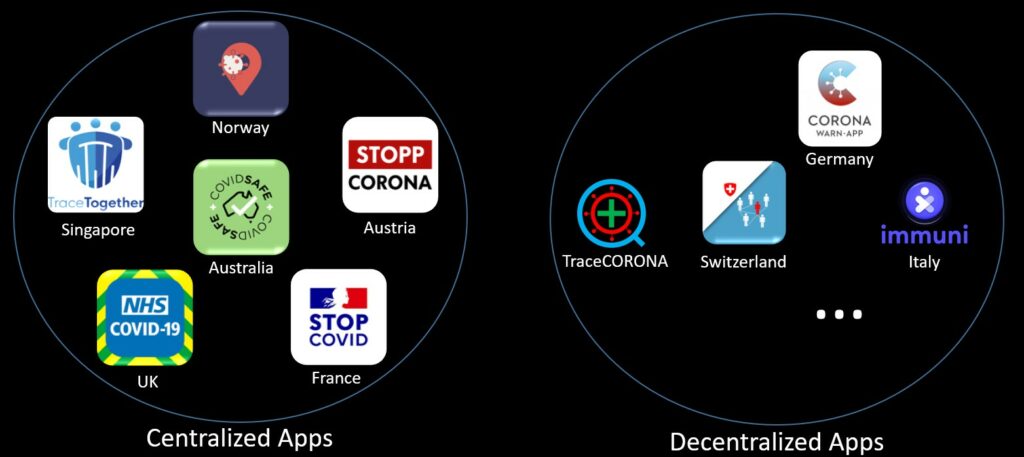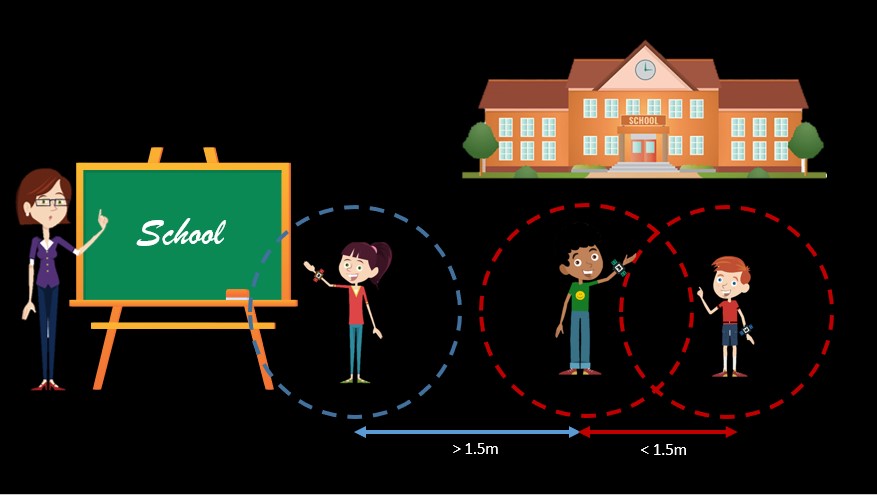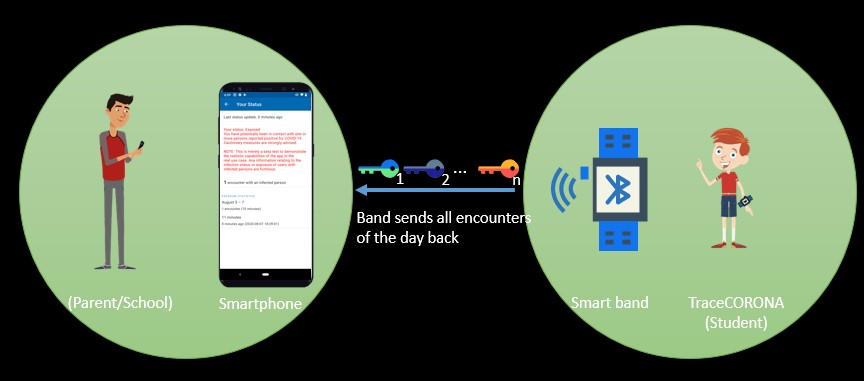Many countries have deployed contact tracing apps for smartphones on a nationwide level. Some countries like Germany and Switzerland utilize the contact tracing algorithm provided by the Exposure Notification API from Apple and Google. Other states have developed their apps using shared approaches and libraries like Singapore and Australia using the BlueTrace framework, or, France and UK utilizing the solution of the PEPP-PT consortium. Some countries like India or Vietnam have chosen to develop their own independent contact tracing apps.
In terms of design concept, existing approaches can be divided in to decentralized and centralized ones as shown in Figure 1.

Existing solutions have, however, several problems in many aspects:
Insufficient flexibility
Statewide or nationwide deployments often provide inflexible solutions and limited functionality, as they represent a minimal compromise in terms of functionality and are often tailored to be exclusively run by a public authority. This makes the roll-out and operation of the tracing system complicated and subject to many political and societal controversies related to public health policy and citizens‘ rights to privacy.
However, many organizations like schools or businesses would like to have to have more flexible solutions that can be tailored to fulfill the particular needs that these organizations would need for protecting their students or employees.
Policy limitations
Many countries have not deployed a country-wide contact tracing app yet. Since such nation-level approaches require active involvement of health authorities in administering and verifying infections, this prevents in many cases private corporations or agile startups to be involved in the development and deployment of contact tracing solutions in practice. Also other policy limitations may hamper the roll-out of alternative tracing app solutions. For instance, Google and Apple only allow in each country or state one single tracing app that has been approved by national health authorities to be published in their app stores.
Dependence on OS vendors
The process of developing and deploying contact tracing apps on smartphones is heavily reliant on major mobile operating system vendors like Apple and Google, resulting in many technical as well as policy problems.
Those countries that have opted for developing solutions that are independent from the Apple/Google Exposure Notification API face many technical issues that are caused by operating system policy restrictions imposed by Google and Apple. For example, on Apple smartphones, the Bluetooth LE communication required for contact sensing cannot run in the background due to policy restrictions imposed by the operating system.
On the other hand, for solutions in that use the Apple/Google Exposure Notification API, access to internal aspects of the tracing solution are very limited. The only aspect that the app has control over is enabling or disabling the tracing function running in OS level. Similarly, the only data the app can receive is the scale of the exposure risk level. Moreover, this approach also faces several security and privacy concerns, e.g., user profiling or relay attacks.
Usability constraints
Smartphone-based tracing solutions also suffer from usability limitations, as carrying a smartphone is inconvenient or impossible in many scenarios like at schools, hospitals, corporations, sports events, beaches, waterparks, funfairs, etc.
Organizational needs
Many organizations, like schools or corporations have needs for performing contact tracing that do not necessarily align well with the needs and requirements of a national or country-level tracing solution. Many businesses and organisations would like to implement their own (private) tracing solutions to have the flexibility of better managing quarantining of employees. To tackle this problem, some manual private contact tracing solutions, e.g., WORK.COM have been introduced.
SmartBand – Future Contact Tracing Solution
Since smartbands by design support Bluetooth Low Energy (BLE) communication, they can be used for Bluetooth-based contact tracing. For example, Figures 2 and 3 show our smartband-based contact tracing concept to be used at schools, where smartphone use during class is usually prohibited for students. In our solution the Bluetooth tracing function is integrated in the smartbands to record encounters and collect meta-data like the distances that students have had to others, as shown in Figure 2. These encounters are synced and cross-checked with encounters reported by infected users. This is done with the help of parents‘/or school advisers’ smartphones or tablets as shown Figure 3. As a result, the system can automatically notify users (students/school staff) whether they have an encounter with an infected user. The advantage of this approach is that the school can isolate students that have been exposed to infected users efficiently, allowing to maintain regular operation of the school for students that have not been exposed to infected persons.


Using smartbands can avoid many problems with smartphones as well as bring other benefits in many aspects:
Convenience
Using smartbands does not suffer from many of the usability constraints mentioned above, as they can be used in many scenarios where smartphones are prohibited or inconvenient to use. This includes scenarios involving children at school, hospitals, corporations, sports and other events, beaches, waterparks, funfairs, etc.
Cost-effective and Health-beneficial Approach
Smartbands are affordable, costing only tens of US dollars. Moreover, smartbands can also provide physiological data and work like a health assistant, e.g., by notifying users when they have been sitting for too long.
Independence and Diversity
Smartbands are independent of Apple and Google, so that smartband manufacturers can freely integrate and optimize the performance of the tracing function in order to improve its reliability and minimize power consumption.
Encousure: Encounter-as-a-Service
To address the insufficient flexibility of statewide or nationwide tracing solutions discussed above we introduce Encousure powered by TraceCORONA, a decentralized and private tracing system. Encousure is flexible and can adapt to the individual needs of organizations like schools or coporations. Encousure provides many features and advantages:
Advanced tracing algorithm
To the best of our knowledge, Encousure is the first tracing approach providing an encounter-specific token establishment scheme for each encounter while other approaches are based on sharing ephemeral (i.e., short-lived) identifiers.
Contact tracing solution for various devices
Encousure is based on a tracing app running on smartphones that has been extensively beta tested for three months. It has also been implemented on a prototype for smart bands.
Flexible Design & Scalable Privacy & Security
Encousure provides flexible solutions for usability as well as privacy/security requirements for the individual needs of each organization.
Diverse Use cases
Encousure provides solutions for diverse, niche, and emerging markets. Besides contract tracing for pandemics, Encousure also provides solutions for contact establishment for messaging and advertising services.
EvoNexus Webinar on Contact Tracing
The Encousure contact tracing solution was introduced and discussed in a webinar examining COVID-19 contact tracing as it relates to wearable wireless technology and software applications in use cases impacting the education system, infrastructure, and students. The Webinar was hosted by EvoNexus, California’s Leading Non-Profit Technology Incubator, and Futurewei, a global leader in wireless technology research and Open Source.
